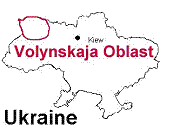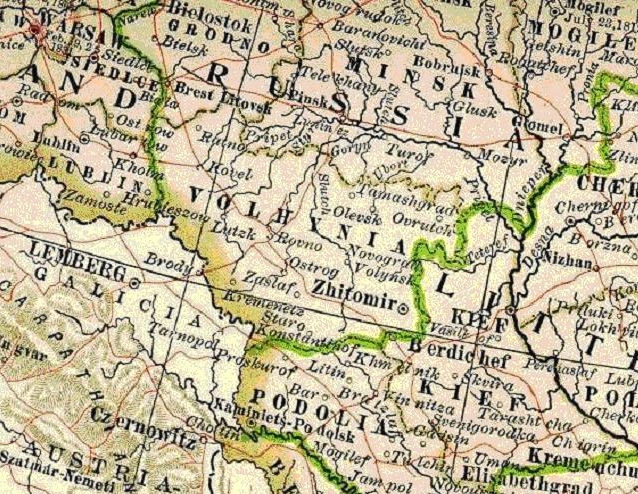
The Germans from Volhynia and Russian PolandDefinitionVolhynia, located in the northwest of present-day Ukraine, borders Belarus in the north, the Carpathian Mountains in the south, and Poland in the west. It was ruled by Poland until the late 18th century, when Poland was partitioned by the Prussian, Austrian, and Russian Empires. After the partition, Volhynia was a gubernia, or province, of the Russian Empire until 1919, when the western part of Volhynia once again became part of Poland. In 1945 the entire area of the Volhynia Gubernia was absorbed into the Soviet Union, but the gubernia system was no longer used and the Volhynia name was used to identify a smaller region, called an oblast, in the western part of the old gubernia. Most of what was the Volhynia Gubernia is now in Ukraine, with a small part of northern Volhynia in Belarus. Its capital was Zhitomir.  Source: http://beepworld.de/members2/joergfroehlich/index.htm SettlementIn Volhynia, early German settlement was sporadic. German craftsmen and merchants had settled in the region as early as the 13th century, and with the expansion of Protestantism, Germans were involved in setting up Protestant schools and played an important part in the cultural development of the area. But the immigration of colonists came later. [1] One of the first colonies was at Koretz in 1783. A few Mennonite agricultural villages from Prussia were established prior to 1793, but most of them moved on to the Black Sea region within a few decades. The first permanent settlement by colonists, mostly from Pomerania, came in 1816 but significant migration into Volhynia did not occur until the 1830s. [2]. The migration to Volhynia was initiated under vastly different circumstances than the migration to other parts of the Russian empire. Polish landlords who had retained land after the Russian occupation were looking for qualified farmers to develop and farm their land. No special privileges were extended to these immigrants except for those which could be provided by the local nobility. It was the shortage of land in their old homes that drove most of the Germans into this region, but some immigration was also motivated by religion: Virtually all German Baptist communities that had been established in the 1850s in Poland emigrated to Volhynia (by 1914 Volhynia would have between 40,000 and 50,000 Baptists, served by about a dozen churches [3]).  Source: http://www.stat.ualberta.ca/people/schmu/giff/volhynia.jpg By 1860, there were only about 5,000 Volhynian Germans in 35 small villages. Then, with the abolition of serfdom in 1861 and the failed Polish Insurrection of 1863, Germans began to flood into this area. By 1871, there were over 28,000 and by the turn of the century, over 200,000 lived in Volhynia. Most of them had come from Poland, with a minority moving there from Wuerttemberg, Pomerania, East Prussia, Silesia, and Galicia. In the late stages of the 19th century, conditions for the Volhynian Germans became progressively worse as they lost more and more of their freedoms and privileges that they had been granted. From 1870 on, thousands emigrated to North America. Under the Soviets, the Volhynian Germans suffered greatly under repression and the collectivization of the land; individual farms were torn town and villages had to be built instead. Small wonder that some Volhynian Germans welcomed the arrival of the German army after the outbreak of the War. Pursuant to an agreement between the Reich and the Soviet Union ethnic Germans from Volhynia were resettled. In December 1939, the first 1,000 Volhynian Germans arrived in the vicinity of Lodz. By February, more than 100,000 persons were moved in from eastern Galicia and Volhynia. Most of them were resettled into the Warthegau where Polish farmers were cruelly expropriated. By 1943/44 altogether 350,000 Germans from Russia were settled in the Warthegau where they received German citizenship. Settlement in AlbertaThe Germans from Volhynia formed small, more or less closed settlements in the 1890s in all three Prairie provinces. In 1894 Germans from Volhynia settled in and around Regina, Rosthern, Yorkton, Langenburg, Lampman, Yellow Grass, Lang, Kipling, Lemberg, Lipton, Mossbank, St. Boswells and Morse. In Manitoba, colonies of Volhynians were started in the vicinity of the Mennonites in Emerson, Gretna, Morris, Brown, Morden and Friedensfeld near Steinbach, as well as east of Winnipeg near Beau-sejour, Goldenbay, Greenbay, Grünwald, and Thalberg, and in the north near Waldersee, Grahamdale, Moosehorn and Camper. In Alberta, they settled in colonies in Wetaskiwin, Brightview, Leduc, Nisku, Bashaw, Ellerslie, Brüderheim, Brüderfeld, New Sarepta, Peace Hill and Golden Spike. Except for the Moravian Brethren, who in 1894 founded the colonies of Brüderheim, Brüderfeld, and New Sarepta, almost all the Germans from Volhynia at that time were Lutheran Protestants. [4] Lutheran Germans from Russia founded Heimthal colony near the Rabbit Hills. To the north of it, in 1892-93, Germans from Volhynia founded Lutherhort congregation. In 1893, the first German Baptists from Volhynia settled in the Leduc farm district. By 1904 as many as a hundred German families had settled there, almost all from Volhynia and mostly Baptists, with a few Lutheran families among them. The area west of Wetaskiwin, which had been settled by some 20 families of Germans from Russia in 1892, continued to grow as a result of the steady influx of Lutherans and Baptists from Volhynia. In 1894 settlers took up land in the area beyond Bittern Lake, west of Camrose. Immigration to this area was particularly strong between 1895 and 1905, and the region was the chief destination of Germans from Volhynia immigrating to western Canada. [5] Notes[1] "Familienforschung in Wolhynien," http://www.wolhynien.de/history.htm. Accessed on March 13, 2004. [2] Jerry Frank. "Germans in Russia and other C.I.S. States." Accessed on January 27, 2005. [3] "Volhynian Baptist pastors," http://www.genealogyunlimited.com/daveobee/bapt.html. Accessed on March 13, 2004. [4] Lehmann, Heinz. The German Canadians: 1750-1937. Immigration, settlement and culture. Translated, edited and introduced by Gerhard P. Bassler (St. John's, NF: Jesperson Presss, 1986), p. 116. [5] Lehmann, pp. 243-245. Sources1. "Wolhyniens Geschichte - vom Ursprung zur Umsiedlung der Wolhyniendeutschen 1939/1940 bis zur Ahnenforschung dieser Region," http://beepworld.de/members2/joergfroehlich/index.htm. Accessed on March 16, 2004. 2. "Familienforschung in Wolhynien," http://www.wolhynien.de/index.htm. Accessed on March 16, 2004. "Volhynian history and geography." 3. "Kurze Geschichte der Wolhyniendeutschen," http://www.wolhynien.de/history.htm. 4. Miller, Donald N. In the midst of wolves. A history of German Baptists in Volhynia, Russia, 1863-1943. Portland, Oregon: Multnomah Printing, 2000. History of 20 German Baptist churches in Volhynia, interwoven with personal histories of their members and leaders, and anecdotes from daily life. 5. An excellent discussion of German settlement in Alberta is provided by Heinz Lehmann in his The German Canadians: 1750-1937. Immigration, settlement and culture (translated, edited and introduced by Gerhard P. Bassler. St. John's, NF: Jesperson Presss, 1986), pp. 239-251. 6. The Historical Society of Germans from Poland and Volhynia has an office and a library in Trinity Lutheran Church in Edmonton (10014-81 Avenue, Edmonton, AB, T6E 1W8. Tel. : (780) 433-1604; email: office@trinity-lutheran.ab.ca). Its holdings include family history books, church history records, Zhitomir church records, pedigree charts, maps, newspapers, photos, etc. President: Mr. Dan Pretzlaff (51236 Range Road 825, Sherwood Park, Tel.: 440-0197; e-mail: ipodolej@hotmail.com). 7. The most important English-language resource on the Germans from Volhynia and Russian Poland is the Society for German Genealogy in Eastern Europe site. Its headquarters and library are located in Calgary. The Society has membership from around the world, and they regularly hold conventions / conferences in Calgary and Edmonton. |
